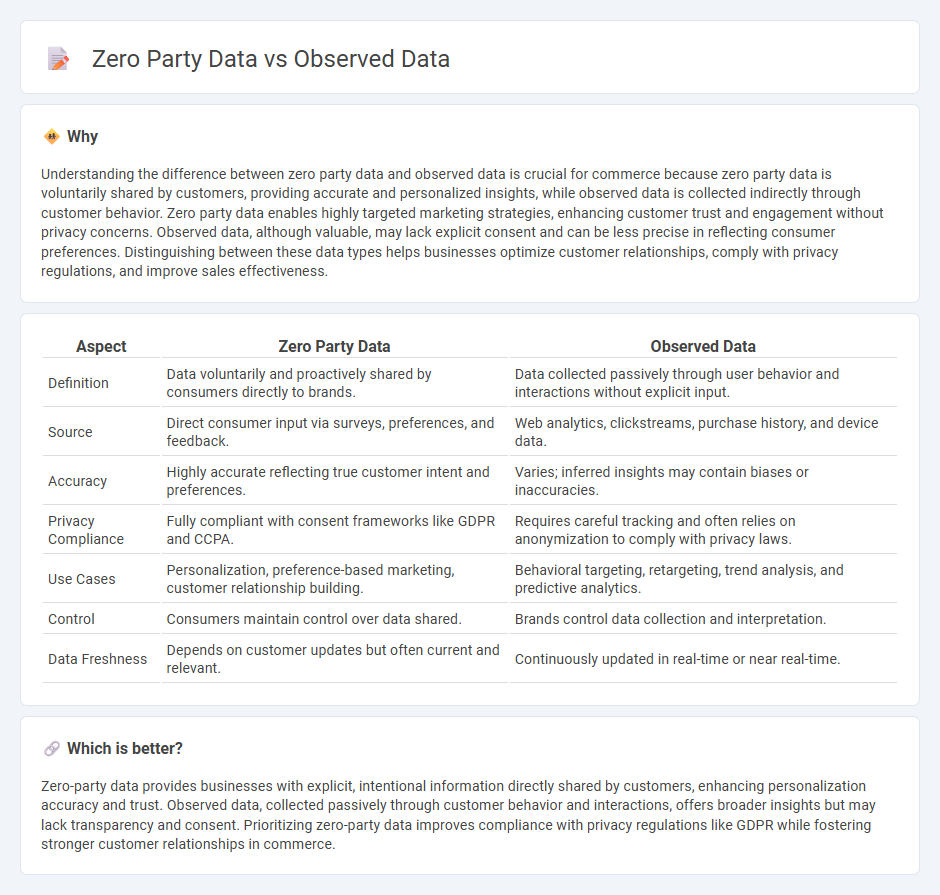
Zero party data involves information that customers intentionally and proactively share with businesses, enhancing personalization and trust. Observed data is collected passively through customer behaviors such as browsing, clicks, and purchase history, providing insights without direct user input. Discover how leveraging both data types can transform your commerce strategy.
Why it is important
Understanding the difference between zero party data and observed data is crucial for commerce because zero party data is voluntarily shared by customers, providing accurate and personalized insights, while observed data is collected indirectly through customer behavior. Zero party data enables highly targeted marketing strategies, enhancing customer trust and engagement without privacy concerns. Observed data, although valuable, may lack explicit consent and can be less precise in reflecting consumer preferences. Distinguishing between these data types helps businesses optimize customer relationships, comply with privacy regulations, and improve sales effectiveness.
Comparison Table
| Aspect | Zero Party Data | Observed Data |
|---|---|---|
| Definition | Data voluntarily and proactively shared by consumers directly to brands. | Data collected passively through user behavior and interactions without explicit input. |
| Source | Direct consumer input via surveys, preferences, and feedback. | Web analytics, clickstreams, purchase history, and device data. |
| Accuracy | Highly accurate reflecting true customer intent and preferences. | Varies; inferred insights may contain biases or inaccuracies. |
| Privacy Compliance | Fully compliant with consent frameworks like GDPR and CCPA. | Requires careful tracking and often relies on anonymization to comply with privacy laws. |
| Use Cases | Personalization, preference-based marketing, customer relationship building. | Behavioral targeting, retargeting, trend analysis, and predictive analytics. |
| Control | Consumers maintain control over data shared. | Brands control data collection and interpretation. |
| Data Freshness | Depends on customer updates but often current and relevant. | Continuously updated in real-time or near real-time. |
Which is better?
Zero-party data provides businesses with explicit, intentional information directly shared by customers, enhancing personalization accuracy and trust. Observed data, collected passively through customer behavior and interactions, offers broader insights but may lack transparency and consent. Prioritizing zero-party data improves compliance with privacy regulations like GDPR while fostering stronger customer relationships in commerce.
Connection
Zero party data is information that customers intentionally share with brands, reflecting their preferences and intentions directly. Observed data, on the other hand, is collected passively through tracking customer behavior and interactions across channels. Combining zero party data with observed data enhances commerce strategies by enabling personalized marketing efforts and improving customer experience through deeper insights into consumer needs and behaviors.
Key Terms
Data Ownership
Observed data is collected through user behavior tracking, often without explicit user consent, leading to limited data ownership by individuals. Zero party data involves users willingly sharing personal information directly with brands, ensuring full ownership and transparency over their data. Discover how embracing zero party data enhances consumer trust and data ownership strategies.
Data Collection Method
Observed data is collected passively through user interactions, such as website behavior, clicks, and purchase history, enabling businesses to analyze patterns without direct user input. Zero-party data is actively shared by consumers, including preferences, intentions, and personal insights provided through surveys or questionnaires, ensuring high accuracy and trust. Explore more to understand how these distinct data collection methods impact marketing effectiveness and personalization strategies.
Customer Consent
Observed data is collected through user behavior tracking and third-party interactions without explicit consent, often raising privacy concerns under regulations like GDPR and CCPA. Zero party data, explicitly shared by customers via surveys, preferences, or direct interactions, ensures full transparency and control over personal information, aligning with customer consent priorities. Explore how leveraging zero party data can enhance trust and compliance in your customer relationship management strategies.
Source and External Links
Observational Data: Exploring What It Is And Where It Can Be Useful - Observational data is gathered by watching and recording natural behaviors or events and provides insights into human behavior, patterns, context, quality assurance, environmental research, market trends, and safety monitoring.
Observational Data: What is it, Types & Insights - QuestionPro - Observational data is collected by observing events or behaviors as they naturally occur without interference and can be structured (standardized, protocol-driven) or unstructured (flexible, open-ended), useful across many disciplines.
Observed Data | Research Rockstar Training & Staffing - Observed data involves passively recording activities such as content engagement or app usage without significant interaction to avoid influencing results, enabling unbiased insights into user behavior.
 dowidth.com
dowidth.com